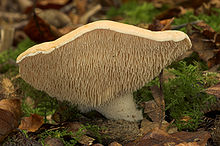Hydnaceae
| Hydnaceae | |
|---|---|

| |
| Hydnum repandum | |
| Scientific classification | |
| Domain: | Eukaryota |
| Kingdom: | Fungi |
| Division: | Basidiomycota |
| Class: | Agaricomycetes |
| Order: | Cantharellales |
| Family: | Hydnaceae Chevall., 1826 |
| Type genus | |
| Hydnum | |
| Genera | |
|
Burgoa ( | |
| Synonyms[1] | |
|
Repetobasidiaceae Jülich | |
The Hydnaceae are a
Taxonomy
History
The family was originally described in 1826 by French botanist
Current status

The placement of the Hydnaceae as a family within the Cantharellales:[10]
Phylogenetic tree presenting the current opinion on relationships among genera:[10]
| Hydnaceae | |
Description
The fruit bodies of species in the family have caps and stems that are usually centrally attached. Colors typically range from white to yellow to orange, and the teeth are typically lighter than the cap surface. The flesh is fleshy and brittle, and monomitic (consisting of generative hyphae only). The generative hyphae are thin-walled, branched, contain septa, and have clamp connections. Spores range in shape from roughly spherical to egg-shaped, have a smooth surface, and are colorless.[13] A distinctive characteristic of many species in the family is the structure of the hymenium (spore-bearing surface), which consists of pendant, toothlike spines.[14]
Habitat and distribution
All species within the Hydnaceae are believed to be
.Economic importance
Several species of Hydnum are edible and Hydnum repandum is commercially collected and marketed in Europe,[17] often under the French name pied de mouton.[18] In North America, the related Hydnum umbilicatum is also commercially collected, sometimes under the name "sweet tooth".[19]
References
- ^ ISBN 978-0-85199-826-8.
- ISBN 0-472-85599-9.
- ^ a b Donk MA. (1964). "A conspectus of the families of Aphyllophorales". Persoonia. 3: 199–324.
- ^ Donk MA. (1933). "Revision der niederländischen Homobasidiomycetae-Aphyllophoraceae II". Medel. Bot. Mus. Univ. Utrecht (in German). 9: 1–278.
- ISBN 0-85198-885-7.
- JSTOR 3761626.
- PMID 17486970. Archived from the original(PDF) on 2011-07-06.
- PMID 17981020.
- S2CID 2471396.
- ^ PMID 35035603.
- ^ S. eximum, S. octosporum
- ^ S. brinkmannii, S. oblongisporum
- ^ "Hydnaceae Chevall. 1826". MycoBank. International Mycological Association. Retrieved 2010-12-16.
- ISBN 0-520-03656-5.
- PMID 17123810.
- S2CID 27559720.
- ^ HYDNUM REPANDUM products, buy HYDNUM REPANDUM products from. alibaba.com. Retrieved on 2010-12-16.
- ^ Pied de Mouton Archived 2010-11-10 at the Wayback Machine. The Mushroom Basket. Retrieved on 2010-12-16.
- ^ Fresh Wild Hedgehog (aka Sweet tooth) Mushrooms. Marx Foods. Retrieved on 2010-12-16.
